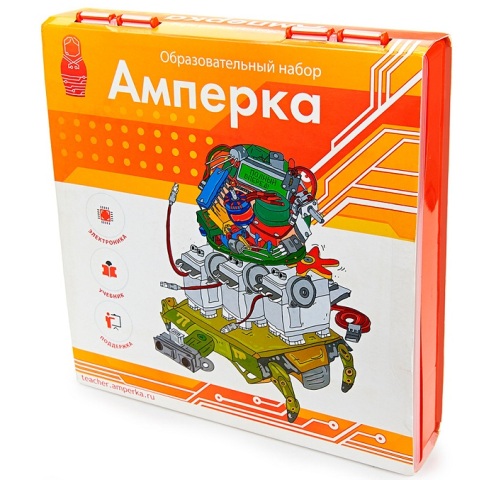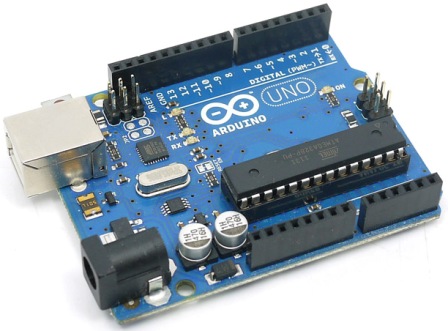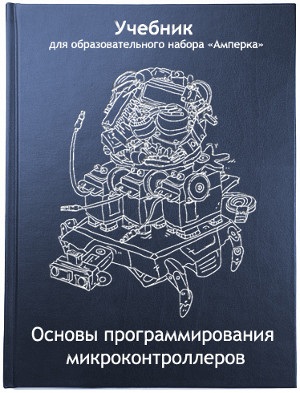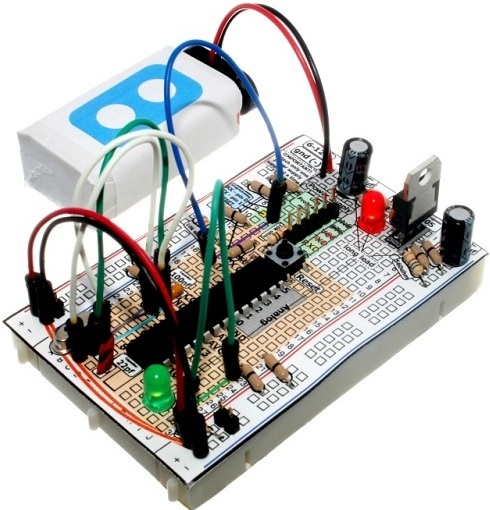Categories: Electrical Reviews
Number of views: 8372
Comments on the article: 0
Amperka educational kit for teaching electronics and robotics
In this review, we’ll talk about the Amperka educational kit produced by the Moscow Amperka LLC, which is a ready-made training course aimed at educating beginners microcontroller application programming, and give the student the opportunity to realize their creative potential by creating their own electronic devices.
The set will allow a beginner to learn to put into practice the laws of electricity, as well as to master the practical application of theoretical material in computer science. The set is ideal for both schools and self mastering Arduino.

The Amprek set includes three components:
-
Electronics;
-
Training course;
-
Online materials.
Electronics
The kit contains all the necessary electronic components, more than 150 parts that are useful for successful completion of the course. It includes resistors, LEDs, transistors, motors, sensors, an LCD screen, a board with a programmable microcontroller Arduino, - in a set of more than 20 items. All components come in a practical plastic box divided into sections.
The kit includes exactly those components that are necessary for a mini-laboratory, they are carefully selected and presented in optimal quantities. According to the training manual included, the beginner will be able to conduct his own electronic experiments and perform additional tasks.
In different lessons of the course, the same components will be used in different ways, in different combinations, working and interacting in the created device in a certain way, allowing the student to better understand how they function, what is the principle of their action.

The brain of the kit is the Arduino board, and each lesson involves programming it. Programming of the controller is carried out from any computer, on any operating system, whether it be MacOS, Windows or Linux. All other accessories are also included.

Safety training is achieved by using power for all devices with a voltage not exceeding 9 volts. A sturdy packaging will not allow the student to damage it. The components of the kit are delivered in excess, so if the student loses something, it’s not scary, there is always a spare component in the box.
The kit contains the following electronic components:
-
Two line sensors;
-
One tilt sensor;
-
Four clock buttons;
-
Two potentiometers;
-
75 connecting wires;
-
One USB cable
-
One connector for the Krona battery;
-
One two-wheeled chassis for the robot;
-
One servo drive with mounts;
-
LCD text screen;
-
Two seven-segment indicators;
-
12 red, 4 green, 4 yellow, 2 three-color LEDs;
-
Two sound piezo emitters;
-
10 bipolar transistors4 field effect transistors;
-
Two chips CD4026;
-
5 rectifier diodes;
-
Digital multimeter with probes;
-
Motor Driver Motor Shield;
-
Port Expander Troyka Shield;
-
Connecting elements.
Training course

The kit includes a textbook written specifically for the course with the Amperka kit. Each lesson involves the use of electronics. The 207-page hardcover textbook contains 17 paragraphs. Each paragraph is one lesson. The course is designed for one lesson every week for six months.
Teachers and students themselves will easily master the subject with the help of this manual, because the presentation of the educational material is from simple to complex. The first paragraphs are devoted microcontroller and the basics of programming, as well as the basic laws of electricity.The next step is to create your own devices, important aspects of development.
Upon completion of the course, the student will be able to create his own autonomous mobile robot. As you already understood, each lesson contains a practical part, each lesson involves learning how to assemble one or more new devices using components that are necessarily present in the kit.
Online materials
On the website of the Amperka company, students can always find any materials that will help them in mastering the course. Materials are presented in the form of educational articles, as well as in the form of video lessons. The site also has a forum where students can discuss projects and find solutions.
Representatives of the Amperka company, in the case of a student or teacher, can answer questions and provide qualified assistance. In addition, the site has a thematic blog where you can read and watch a lot of interesting things about programming and design at any time.
How is the training
The course is primarily associated with the Arduino platform, which is popular today, which, thanks to its simplicity and ease of use, allows many people to realize their creative potential.
With Arduino, you don’t need to get into very complex physical processes and in programming controllers in a pure form, because a person will acquire deeper knowledge at the institute if he wants.
During this course, a person will learn to combine various components with Arduino, load programs into it, and create devices, the list of which is limited only by the imagination of the developer, that is, the student. It is this principle that underlies the Amperca course.
First, the child gets acquainted with the microcontroller and the Arduino board, he learns using a computer to download the program to the controller in order to get one or another behavior of the device. There is a mastery of how the source code is written and how.
After that, electronic components responsible for sound, light, mechanical movements are connected to Arduino in various combinations, sensors are connected, and it is shown how the components interact with each other and with the environment.

As a result, an autonomous mobile robot is created, which is a full-fledged device in which all the knowledge acquired by the student during the training is implemented. Each lesson, starting with the theoretical part, flows into the practical part, where the acquired skill must be put into practice, consolidating the knowledge gained in the material.
This knowledge may be the next step in programming or in understanding the functioning of physical devices and components. One way or another, each lesson is related to DIY assembly of a new Arduino-based device.
The student will not have to lay and solder the printed circuit boards, because the kit includes a breadboard and breadboard connecting wires. It is possible to assemble electrical circuits without the need for soldering. The desired component is simply inserted into the hole on the breadboard, is fixed, and the connection of blocks among themselves is carried out using breadboard wires.
So, having at first only superficial ideas about physical processes, and having a weak idea of the applicability of computer science, the student will master the C ++ programming skill, starting from variables, ending with the basics of object-oriented programming. He will learn to work with Arduino, write programs, do controller firmware.
Designing electronic circuits, translating them into reality, applying the laws of electricity - all this will be the result of classes with a set of "Amperka". The student will be able to assemble, verify, correct, modify their devices, because on the breadboard it is all very easy to do.
Electronics will be controlled from a program recorded in the Arduino controller, and this is always the practice in each lesson, which will become a wonderful base for entering a technical university.
See also on our website:Device and programming microcontrollers for beginners
See also at bgv.electricianexp.com
:
